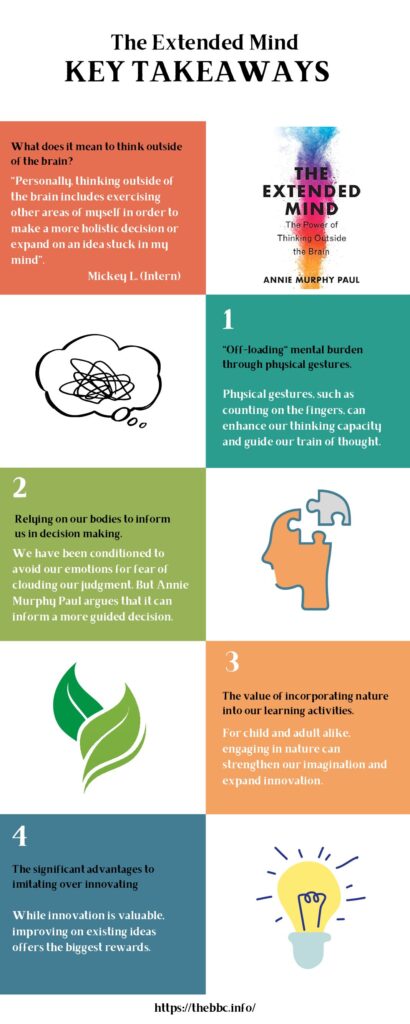Infographic and Concluding Takeaways by: Jim Bellis and Mickey Lin
The Extended Mind: The Power of Thinking Outside of the Brain by Annie Murphy Paul offers us an abundance of ideas and perspectives to enhance how we think, work, learn and create.
What does it mean to think outside of the brain? In her Prologue, the author conveys the essence of this concept by saying, “… the mind is something more like the nest-building bird I spotted on my walk, plucking a bit of string here, a twig there, constructing a whole out of available parts. For humans these parts include, most notably, the feelings and movements of our bodies, the physical spaces in which we learn and work; and the other minds with which we interact — our classmates, colleagues, teacher, supervisors, friends. Sometimes all three elements come together in especially felicitous fashion …” In the rest of the book, she brings this appealing, rather abstract description into sharp focus.
My intent here is not to summarize what the author discusses. That would be well nigh impossible given the expanse of what is presented in the book and not much if any value.
Best you read the book in its entirety for that. Instead, I have singled out a small number of what I consider to be the most exceptional ideas which I have already or plan to incorporate into my personal and professional life.
1. “Off-loading” mental burden through physical gestures. Many of the ideas the author discusses that can help our thinking capacity she notes have been overlooked or even denigrated in our culture. One small example of this is the act of counting on our fingers. Where we not all taught this is something we should not do? Turns out it affords us a broader bandwidth for our mental processes. The author’s discussion of this deals with a range of physical gestures that operate in the same way. (See Thinking with Gestures chapter.)
2. Relying on our bodies to inform us in decision making. I have disciplined myself over the years not to rely on “my gut.” The notion being gut feelings are not to be trusted. The author has dissuaded me that bodily feelings — gut and otherwise — should indeed be listened to. I have taken this to heart. I now give significant weight to what I feel as I decide on important and difficult matters. (See Thinking with Sensations chapter.)
3. The value of incorporating nature into our learning activities. This is directed to children and adults alike. The author emphasises the advantage of children playing with natural objects, e.g. leaves, pine cones, sea shells, etc. rather than “toys” in expanding their imaginations. For adults, “spending time in nature can promote innovative thinking …”. (See Thinking with Natural Spaces chapter.)
4. The significant advantages to imitating over innovating. I’ve saved this for last. I think it’s worth the entire price of admission. Here the author cites extensive research establishing that those who take and rework the undertakings, products, projects or whatever of others, which had produced less than successful results, reap the benefits several fold that the innovators failed to achieve. The author states, “Engaging in effective imitation is like being able to think with other people’s brains — like getting a direct download of others’ knowledge and experience.” Here is one of those culturally denigrated ideas that I mentioned above. “Imitator” is pejorative in our society, whereas “innovator” is extaled. When in reality much can be gained by the role of “imitator” in taking a good idea, finding the faults of its initial instantiation and correcting the shortcomings.
I believe this is of special significance for those of us in the field of International Development. We should be spending more time and energy evaluating, analyzing and re-engineering past development projects to find projects of potential worth that possibly foundered or did not reach their full potential because of errors made, opportunities overlooked or aspects misaligned. (See Thinking with Experts chapter.)
The Extended Mind is a book that deserves to be read and re-read. Each pass through it will yield fresh and worthy ideas — guaranteed.
